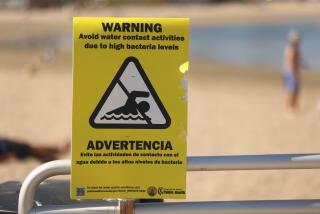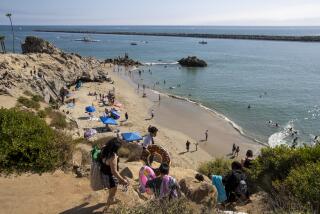Report of Unhealthy Beaches Brings a Plea for Controls
Sewage spills and polluted runoff forced the closing of California’s beaches more than 4,500 times last year, with three dozen beaches remaining off limits to swimmers for three months or more because of high bacteria counts, according to a report by the Natural Resources Defense Council, a nationwide environmental group.
The number of closings in California actually fell 31% in 2002 from the previous year, a drop that the environmental group attributed largely to last year’s drought. Runoff from storm water often causes breaks in sewer lines and washes pollutants from city streets and animal feedlots into the sea.
Yet the number of closings in 2002 was the second highest in the 13 years the organization has been compiling national statistics.
The council said tighter controls on sewage overflows and polluted runoff are needed if the nation is to reduce the more than 12,000 closings and advisories for bacteria and other pathogens that have been linked by scientists to ear infections and respiratory and stomach illnesses.
“America’s beachgoers should feel confident that a visit to the beach will not be followed by a visit to the doctor,” said the report, called “Testing the Waters.”
“We need to know that the waters in which we swim, surf and dive are safe.”
In a separate report issued Tuesday, the Bluewater Network released test results showing that the levels of benzene and MTBE, a gasoline additive, spiked in the waters of the San Francisco Bay shortly after a five-hour jet-ski race was held in Benicia. The levels of these two toxic compounds were close to zero before the race and then exceeded health standards by about three to seven times, according to the environmental group, which is trying to expel these watercraft from lakes in national parks and other bodies of water.
Orange County continues to have more closings than any other county in the nation. Orange County officials decided last year to start upgrading sewage treatment facilities, in part to protect popular sandy beaches that were closed or posted with health warning signs 1,671 times last year.
Los Angeles County had 913 closings and health warnings last year, the second most among counties in the state.
David Beckman, a senior attorney with the environmental group, said that part of the reason is that these two counties have large populations living next to coastal waters and that they do a better job of monitoring their beaches than just about any other jurisdiction in the country.
“It’s true, the more you test, the more pollution you find,” Beckman said.
He pointed out that last year San Diego County, another urban county with popular beaches, scaled back the number of locations it tested for bacteria. The county reported a 40% decline in the number of closings and health advisories last year, dropping from 931 in 2001 to 556 in 2002.
In most cases in California, closings or health advisories were the result of elevated levels of bacteria, which often indicate the presence of human and animal waste. Yet in 77% of those cases, public heath officials could not pinpoint the sources of the pollution.
Scientists suspect that coastal waters are tainted with runoff from farms and city streets, which collect pet droppings, fertilizers, oil and spilled chemicals that wash into storm drains and into the ocean.
“We don’t have controls in place to fix this very important public health issue,” Beckman said.
Jeff Hobbs, spokesman for a coalition of cities opposing stricter regulations, said cities need more guidance -- and more money -- from state and federal officials.
“They say we need to clean up our beaches,” Hobbs said. “But how do we do that? And they are telling us to do it without any funding. We are being asked to spend taxpayer money we don’t have.”
More to Read
Sign up for Essential California
The most important California stories and recommendations in your inbox every morning.
You may occasionally receive promotional content from the Los Angeles Times.










